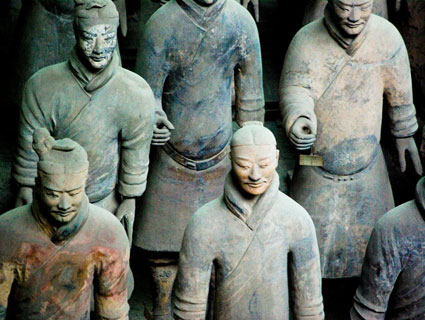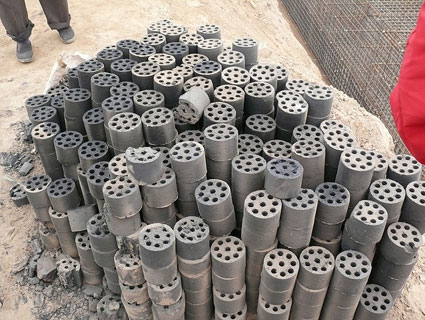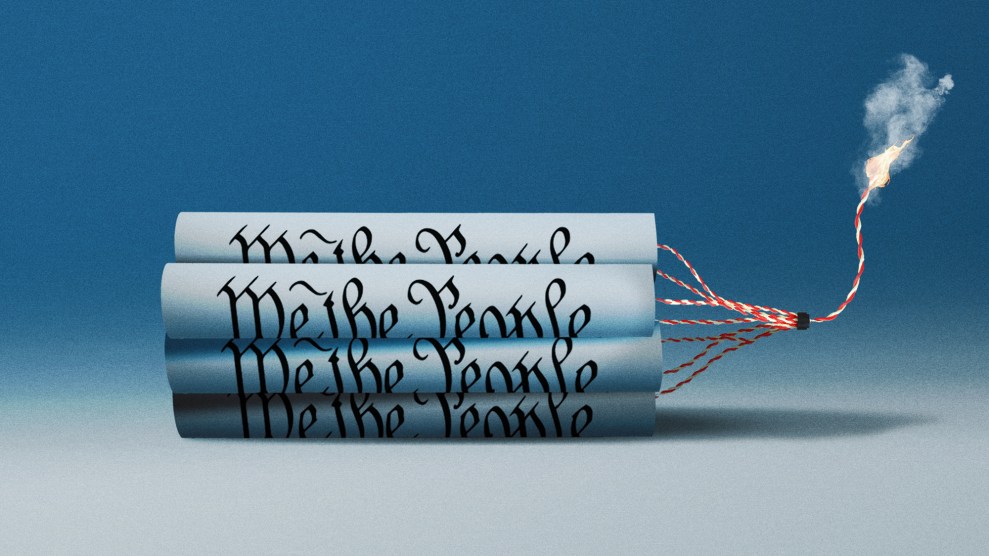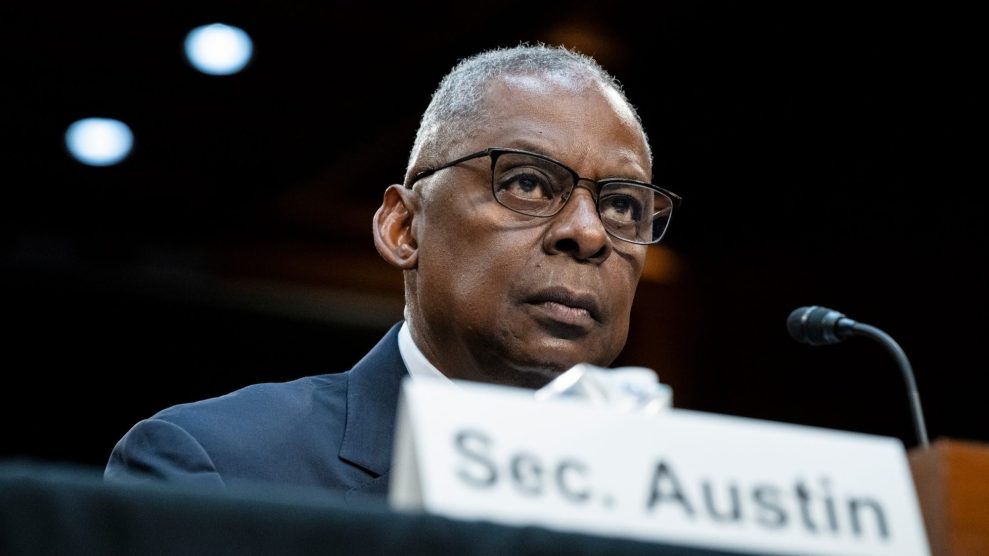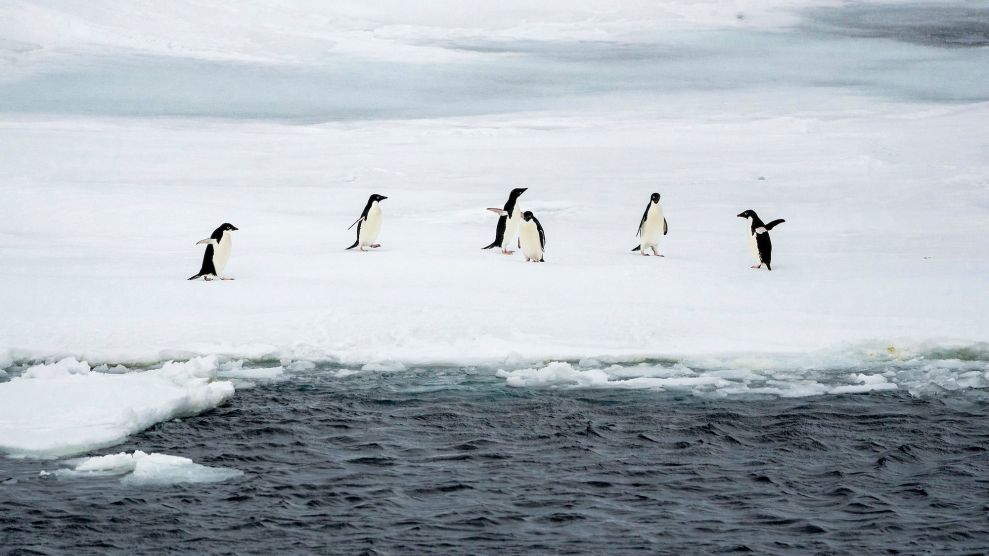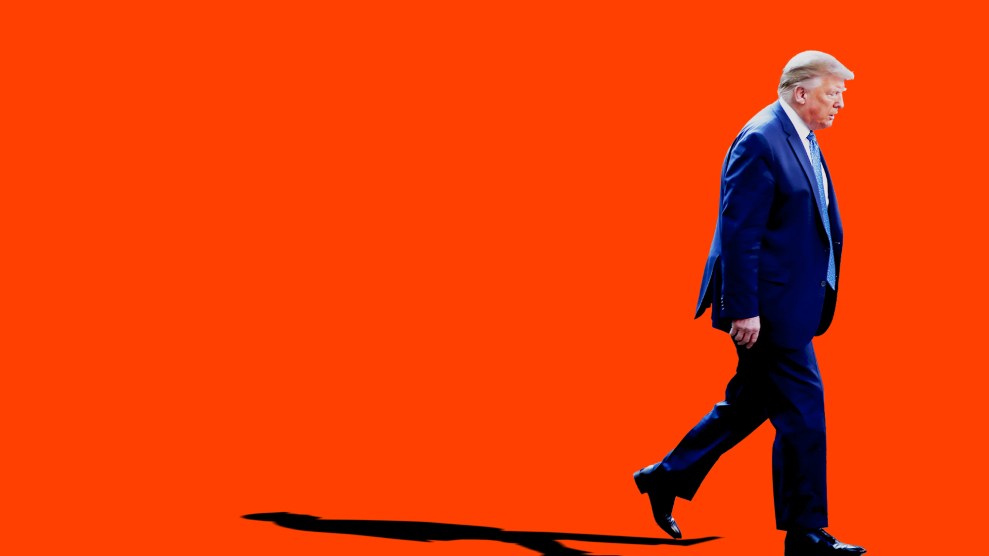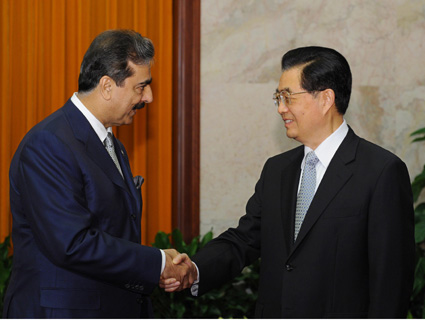
Chinese President Hu Jintao (R) meets with Pakistani Prime Minister Yousuf Raza Gilani in Beijing on May 20, 2011.Rao Aimin/Xinhua/Zuma
![]() This story first appeared on the TomDispatch website.
This story first appeared on the TomDispatch website.
Washington often acts as if Pakistan were its client state, with no other possible patron but the United States. It assumes that Pakistani leaders, having made all the usual declarations about upholding the “sacred sovereignty” of their country, will end up yielding to periodic American demands, including those for a free hand in staging drone attacks in its tribal lands bordering Afghanistan. This is a flawed assessment of Washington’s long, tortuous relationship with Islamabad.
A recurring feature of the Obama administration’s foreign policy has been its failure to properly measure the strengths (as well as weaknesses) of its challengers, major or minor, as well as its friends, steadfast or fickle. To earlier examples of this phenomenon, one may now add Pakistan.
That country has an active partnership with another major power, potentially a viable substitute for the US should relations with the Obama administration continue to deteriorate. The Islamabad-Washington relationship has swung from close alliance in the Afghan anti-Soviet jihad years of the 1980s to unmistaken alienation in the early 1990s, when Pakistan was on the US watch list as a state supporting international terrorism. Relations between Islamabad and Beijing, on the other hand, have been consistently cordial for almost three decades. Pakistan’s Chinese alliance, noted fitfully by the US, is one of its most potent weapons in any future showdown with the Obama administration.
Another factor, also poorly assessed, affects an ongoing war. While, in the 1980s, Pakistan acted as the crucial conduit for US aid and weapons to jihadists in Afghanistan, today it could be an obstacle to the delivery of supplies to America’s military in Afghanistan. It potentially wields a powerful instrument when it comes to the efficiency with which the US and its NATO allies fight the Taliban. It controls the supply lines to the combat forces in that landlocked country.
Taken together, these two factors make Pakistan a far more formidable and independent force than US policymakers concede publicly or even privately.
The Supply Line as Jugular
Angered at the potential duplicity of Pakistan in having provided a haven to Osama bin Laden for years, the Obama administration seems to be losing sight of the strength of the cards Islamabad holds in its hand.
To supply the 100,000 American troops now in Afghanistan, as well as 50,000 troops from other NATO nations and more than 100,000 employees of private contractors, the Pentagon must have unfettered access to that country through its neighbors. Among the six countries adjoining Afghanistan, only three have seaports, with those of China far too distant to be of practical use. Of the remaining two, Iran—Washington’s number one enemy in the region—is out. That places Pakistan in a unique position.
Currently about three-quarters of the supplies for the 400-plus US and coalition bases in Afghanistan—from gigantic Bagram Air Base to tiny patrol outposts—go overland via Pakistan or through its air space. These shipments include almost all the lethal cargo and most of the fuel needed by US-led NATO forces. On their arrival at Karachi, the only major Pakistani seaport, these supplies are transferred to trucks, which travel a long route to crossing points on the Afghan border. Of these, two are key: Torkham and Chaman.
Torkham, approached through the famed Khyber Pass, leads directly to Kabul, the Afghan capital, and Bagram Air Base, the largest US military facility in the country. Approached through the Bolan Pass in the southwestern Pakistani province of Baluchistan, Chaman provides a direct route to Kandahar Air Base, the largest US military camp in southern Afghanistan.
Operated by some 4,000 Pakistani drivers and their helpers, nearly 300 trucks and oil tankers pass through Torkham and another 200 through Chaman daily. Increasing attacks on these convoys by Taliban-allied militants in Pakistan starting in 2007 led the Pentagon into a desperate search for alternative supply routes.
 With the help of NATO member Latvia, as well as Russia, and Uzbekistan, Pentagon planners succeeded in setting up the Northern Distribution Network (NDN). It is a 3,220-mile railroad link between the Latvian port of Riga and the Uzbek border city of Termez. It is, in turn, connected by a bridge over the Oxus River to the Afghan town of Hairatan. The Uzbek government, however, allows only non-lethal goods to cross its territory. In addition, the Termez-Hairatan route can handle no more than 130 tons of cargo a day. The expense of shipping goods over such a long distance puts a crimp in the Pentagon’s $120 billion annual budget for the Afghan War, and couldn’t possibly replace the Pakistani supply routes.
With the help of NATO member Latvia, as well as Russia, and Uzbekistan, Pentagon planners succeeded in setting up the Northern Distribution Network (NDN). It is a 3,220-mile railroad link between the Latvian port of Riga and the Uzbek border city of Termez. It is, in turn, connected by a bridge over the Oxus River to the Afghan town of Hairatan. The Uzbek government, however, allows only non-lethal goods to cross its territory. In addition, the Termez-Hairatan route can handle no more than 130 tons of cargo a day. The expense of shipping goods over such a long distance puts a crimp in the Pentagon’s $120 billion annual budget for the Afghan War, and couldn’t possibly replace the Pakistani supply routes.
There is also the Manas Transit Center leased by the US from the government of Kyrgyzstan in December 2001. Due to its proximity to Bagram Air Base, its main functions are transiting coalition forces in and out of Afghanistan, and storing jet fuel for mid-air refueling of US and NATO planes in Afghanistan.
The indispensability of Pakistan’s land routes to the Pentagon has given its government significant leverage in countering excessive diplomatic pressure from or continued violations of its sovereignty by Washington. Last September, for instance, after a NATO helicopter gunship crossed into Pakistan from Afghanistan in hot pursuit of insurgents and killed three paramilitaries of the Pakistani Frontier Corps in the tribal agency of Kurram, Islamabad responded quickly.
It closed the Khyber Pass route to NATO trucks and oil tankers, which stranded many vehicles en route, giving Pakistani militants an opportunity to torch them. And they did. Admiral Mike Mullen, chairman of the Joint Chiefs of Staff, issued a written apology to his Pakistani counterpart General Ashhaq Parvez Kayani, conveying his “most sincere condolences for the regrettable loss of your soldiers killed and wounded on 30 September.” Anne Patterson, the US ambassador to Pakistan, issued an apology for the “terrible accident,” explaining that the helicopter crew had mistaken the Pakistani paratroopers for insurgents. Yet Pakistan waited eight days before reopening the Torkham border post.
Pakistan’s Other Cards: Oil, Terrorism, and China
In this region of rugged terrain, mountain passes play a crucial geopolitical role. When China and Pakistan began negotiating the demarcation of their frontier after the 1962 Sino-Indian War (itself rooted in a border dispute), Beijing insisted on having the Khunjerab Pass in Pakistani-administered Kashmir. Islamabad obliged. As a result, the 2,000-square-mile territory it ceded to China as part of the Sino-Pakistan Border and Trade Agreement in March 1963 included that mountain pass.
That agreement, in turn, led to the building of the 800-mile-long Karkoram Highway linking Kashgar in China’s Xinjiang Region and the Pakistani town of Abbottabad, now a household name in America. That road sealed a strategic partnership between Beijing and Islamabad that has strong geopolitical, military, and economic components.
Both countries share the common aim of frustrating India’s aspiration to become the regional superpower of South Asia. In addition, the Chinese government views Pakistan as a crucial ally in its efforts to acquire energy security in the coming decades.
Given Pakistan’s hostility toward India since its establishment in 1947, Beijing made an effort to strengthen that country militarily and economically following its 1962 war with India. After Delhi exploded a “nuclear device” in 1974, China actively aided Islamabad’s nuclear-weapons program. In March 1984, its nuclear testing site at Lop Nor became the venue for a successful explosion of a nuclear bomb assembled by Pakistan. Later, it passed on crucial missile technology to Islamabad.
During this period, China emerged as the main supplier of military hardware to Pakistan. Today, nearly four-fifths of Pakistan’s main battle tanks, three-fifths of its warplanes, and three-quarters of its patrol boats and missile crafts are Chinese-made. Given its limited resources, Islamabad cannot afford to buy expensive American or Western arms and has therefore opted for cheaper, less advanced Chinese weapons in greater numbers. Moreover, Pakistan and China have an ongoing co-production project involving the manufacture of JF-17 Thunder fighter aircraft, similar to America’s versatile F-16.
As a consequence, over the past decades a pro-China lobby has emerged in the Pakistani officer corps. It was therefore not surprising when, in the wake of the American raid in Abbottabad, Pakistani military officials let it be known that they might allow the Chinese to examine the rotor of the stealth version of the damaged Black Hawk helicopter left behind by the US Navy SEALS. That threat, though reportedly not carried out, was a clear signal to the US: if it persisted in violating Pakistan’s sovereignty and applying too much pressure, the Pakistanis might choose to align even more closely with Washington’s rival in Asia, the People’s Republic of China. To underline the point, Prime Minister Yousuf Raza Gilani traveled to Beijing two weeks after the Abbottabad air raid.
Gilani’s three-day visit involved the signing of several Sino-Pakistani agreements on trade, finance, science, and technology. The highpoint was his meeting with Chinese President Hu Jintao. Following that summit, an official spokesperson announced Beijing’s decision to urge Chinese enterprises to strengthen their economic ties with Pakistan by expanding investments there.
Among numerous Sino-Pakistani projects in the pipeline is the building of a railroad between Havelian in Pakistan and Kashgar in China, a plan approved by the two governments in July 2010. This is expected to be the first phase of a far more ambitious undertaking to connect Kashgar with the Pakistani port of Gwadar.
A small fishing village on the Arabian Sea coastline of Baluchistan, Gwadar was transformed into a modern seaport in 2008 by the China Harbor Engineering Company Group, a subsidiary of the China Communications Construction Company Group, a giant state-owned corporation. The port is only 330 miles from the Strait of Hormuz at the mouth of the Persian Gulf through which flows much of China’s supplies of Middle Eastern oil. In the wake of the Gilani visit, China has reportedly agreed to take over future operation of the port.
More than a decade ago, China’s leaders decided to reduce the proportion of its oil imports transported by tanker because of the vulnerability of the shipping lanes from the Persian Gulf and East Africa to its ports. These pass through the narrow Malacca Strait, which is guarded by the US Navy. In addition, the 3,500-mile-long journey—to be undertaken by 60% of China’s petroleum imports—is expensive. By having a significant part of its imported oil shipped to Gwadar and then via rail to Kashgar, China would reduce its shipping costs while securing most of its petroleum imports.
At home, the Chinese government remains wary of the Islamist terrorism practiced by Muslim Uighurs agitating for an independent East Turkestan in Xinjiang. Some of them have links to al-Qaeda. Islamabad has long been aware of this. In October 2003, the Pakistani military killed Hasan Mahsum, leader of the East Turkestan Islamic Movement, and in August 2004, the Pakistani and Chinese armies conducted a joint anti-terrorism exercise in Xinjiang.
Almost seven years later, Beijing coupled its satisfaction over the death of Osama bin Laden with praise for Islamabad for pursuing what it termed a “vigorous” policy in combatting terrorism. In stark contrast to the recent blast of criticism from Washington about Pakistan’s role in the war on terrorism, coupled with congressional threats to drastically reduce American aid, China laid out a red carpet for Gilani on his visit.
Referring to the “economic losses” Pakistan had suffered in its ongoing counter-terrorism campaigns, the Chinese government called upon the international community to support the Pakistani regime in its attempts to “restore national stability and development in its economy.”
The Chinese response to bin Laden’s killing and its immediate aftermath in Pakistan should be a reminder to the Obama administration: in its dealings with Pakistan in pursuit of its Afghan goals, it has a weaker hand than it imagines. Someday, Pakistan may block those supply lines and play the China card to Washington’s dismay.
Dilip Hiro is the author of 32 books, the latest being After Empire: The Birth of A Multipolar World (Nation Books). His upcoming book on jihadists in South Asia will be published by Yale University Press later in the year. To stay on top of important articles like these, sign up to receive the latest updates from TomDispatch.com here.
